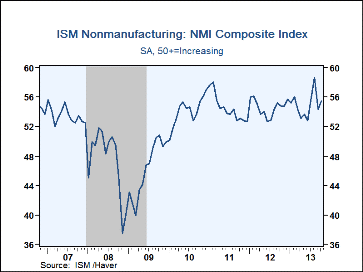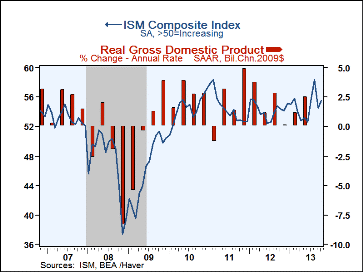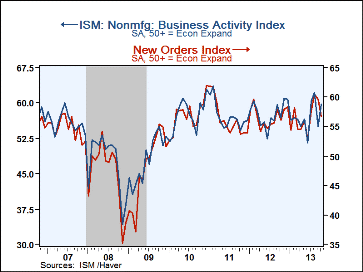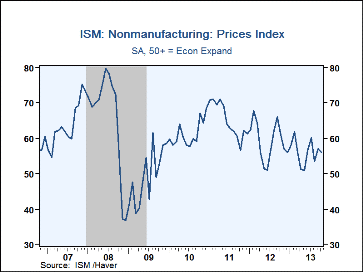 Global| Nov 05 2013
Global| Nov 05 2013U.S. ISM Nonmanufacturing Index Improves Modestly
by:Tom Moeller
|in:Economy in Brief
Summary
The Composite Index for the service and construction sectors from the Institute for Supply Management (ISM) recovered moderately to 55.4 during October after a sharp decline to 54.4 in September. The gain beat consensus expectations [...]
The Composite Index for the service and construction sectors from the Institute for Supply Management (ISM) recovered moderately to 55.4 during October after a sharp decline to 54.4 in September. The gain beat consensus expectations for a further slip to 54.0. The figure remained, however, below the Q3 average of 56.3. During the last ten years there has been a 76% correlation between the level of the nonmanufacturing composite index and the q/q change in real GDP for the service and the construction sectors.
Haver Analytics calculates a composite index using the ISM nonmanufacturing series and the ISM manufacturing sector index released Friday. The October figure improved to 55.5 but remained below the Q3 average of 56.3. During the last ten years there has been a 74% correlation between the composite index and the quarterly change in real GDP.
The business activity series improved and made up most of its September decline. The employment index also recovered most of its September decline. Since the series' inception in 1997, there has been an 88% correlation between the level of the ISM nonmanufacturing employment index and the m/m change in payroll jobs in the service-producing plus the construction industries. Working the other way, the new orders index fell to its lowest level since June. In addition, the supplier delivery series fell sharply, indicating the fastest delivery speeds since December.
The prices paid index slipped to 56.1. Sixteen percent of respondents indicated higher prices while 7% reported them lower. Since inception ten years ago, there has been a 65% correlation between the price index and the q/q change in the GDP services chain price index.
Beginning with the January 2008 Nonmanufacturing Report On Business, the composite index is calculated as an indication of overall economic conditions for the non-manufacturing sector. It is a composite index based on the diffusion indices of four of the indicators (business activity, new orders, employment and supplier deliveries) with equal weights.
The ISM data are available in Haver's USECON database. The expectations figure from ACTION ECONOMICS is in the AS1REPNA database.
Implied Rate Correlations and Policy Expectations from the Federal Reserve Bank of San Francisco is available here.
| ISM Nonmanufacturing Survey (SA) | Oct | Sep | Aug | Oct'12 | 2012 | 2011 | 2010 |
|---|---|---|---|---|---|---|---|
| Composite Diffusion Index | 55.4 | 54.4 | 58.6 | 54.8 | 54.6 | 54.5 | 54.1 |
| Business Activity | 59.7 | 55.1 | 62.2 | 56.8 | 57.7 | 57.2 | 57.6 |
| New Orders | 56.8 | 59.6 | 60.5 | 56.1 | 56.6 | 56.3 | 57.0 |
| Employment | 56.2 | 52.7 | 57.0 | 54.8 | 53.5 | 52.4 | 49.8 |
| Supplier Deliveries (NSA) | 49.0 | 50.0 | 54.5 | 51.5 | 50.6 | 51.9 | 52.2 |
| Prices Index | 56.1 | 57.2 | 53.4 | 60.8 | 59.3 | 65.1 | 61.4 |
Tom Moeller
AuthorMore in Author Profile »Prior to joining Haver Analytics in 2000, Mr. Moeller worked as the Economist at Chancellor Capital Management from 1985 to 1999. There, he developed comprehensive economic forecasts and interpreted economic data for equity and fixed income portfolio managers. Also at Chancellor, Mr. Moeller worked as an equity analyst and was responsible for researching and rating companies in the economically sensitive automobile and housing industries for investment in Chancellor’s equity portfolio. Prior to joining Chancellor, Mr. Moeller was an Economist at Citibank from 1979 to 1984. He also analyzed pricing behavior in the metals industry for the Council on Wage and Price Stability in Washington, D.C. In 1999, Mr. Moeller received the award for most accurate forecast from the Forecasters' Club of New York. From 1990 to 1992 he was President of the New York Association for Business Economists. Mr. Moeller earned an M.B.A. in Finance from Fordham University, where he graduated in 1987. He holds a Bachelor of Arts in Economics from George Washington University.










